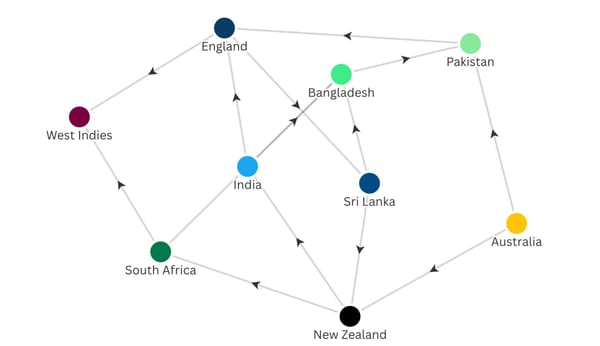Notes on Ind v Aus and NZ v Eng
An omnipresent look at both Tests
Just an announcement, you will see that there is a second credit on this piece. Shayan Ahmad Khan has started writing here. And he will be adding to these pieces, and soon writing his own. He is a hugely talented young writer, and I’m very excited to have him here.
India v Australia
Warner's continued struggle
I get that David Warner struggles when he tours. But I find it interesting how away from home he can look so poor against the new ball. There have been times in the last two Tests where I honestly don’t know how he can make any runs.
He’s so slow picking the ball up. Siraj turned him into a piñata. Shami gets one through him early on at will at the moment. We know that these are quality bowlers, but it does seem to be a pattern.
He now has the lowest average among openers to have played at least 15 innings in India. At home, Warner looks like the most confident stater you will ever see, and away he has all the confidence of roadkill.
That Ashwin over
Australia looked on course for a big first innings total with Khawaja and Labuschagne in the middle. Apart from Warner, the Australian batters did not look troubled in the first session of the day.
And then came Ashwin.
He beat Marnus on his forward defence with a delivery that turned into the right-hander. He was deceived by the magician of spin bowling, who kept drawing him forward throughout his innings. Two balls later, he bowled a ball that kept low and turned away from Smith, who played away from the body and edged the ball to the wicket-keeper.
The control Ashwin has over his spin bowling is artistic.
Ashton Agar is number four
There is little doubt that when Agar turned up for this tour he thought he was the second-choice spinner. Todd Murphy was better than anyone expected and took his spot in the first match, despite the fact that the young offie can’t bat.
Agar’s batting is usually overrated, but at number eight, or nine, he certainly would have made the tail a bit more solid. Though as a lefty he would have faced Ashwin, so maybe not.
But even without Green, Australia’s only other all-rounder, he still couldn’t get into the first game. So he went from probably thinking he would play in the first Test, to thinking he would get a chance in the second. When Green’s fitness
Then Mitchell Swepson went home, and Matt Kuhnemann was sent out. And it is the young SLA bowler who took three wickets in 2022 at 60 is now making his debut.
But Agar doesn’t play First Class cricket much any more. He has played 10 in the last four years. In them, he took 20 wickets at 60. And yet he was still taken out as number two. And he is currently the fourth choice.
So Agar thought he was the number two spinner, and the number two all-rounder. Has now been overlooked for both roles in consecutive Tests, even with injuries. He is currently the fourth-choice spinner. If Swepson comes back to India, is he even the fifth choice?
The real question should be, how bad has Agar been bowling in the nets?
Head’s slice
I watched Head facing Ashwin through my fingers, it feels unfair for him to even have to go out and play it. When he came down the wicket to hit a boundary I marked it down as a dismissal. But the rest of that over was him getting hit on the bad down the wicket and not being entirely sure of where the ball was.
But he did survive, and even if he looked slightly unsure, he didn’t look as bad as I imagined. In fact, Ashwin seemed to be bowling better to the right-handers than the left-handers in this period. And with how bad some Australian batters have looked in their first few balls, I figured Head was at least last stage one.
Then the next over Shami came around the wicket bowled one back of a lengthy that seemed away and Head’s feet were stuck in the crease and he sliced it to slip.
I am trying to work out if this is better or worse than Ashwin dismissing him. It’s definitely worse.
Peter Handscomb proving his worth against spin
Peter Handscomb displayed why he was backed by the team management to start ahead of Travis Head. It was a measured knock with a solid control percentage of 87. More conventional and assured, Handscomb relied on his defence, watched for loose balls, and occasionally made back-foot shots.
We talked about how Australia did not really build a lot of partnerships in the first Test. However, they looked a lot more assured in this match. Australia appeared the most in control throughout the day when Khawaja and Handscomb scored 59 runs for the fifth wicket in the second. He got some vital help from the lower order, as they managed to add 95 runs for the last 4 wickets.
Jadeja completes a rare double of 2500+ Test runs & 250+ wickets
Ravi Jadeja became only the 14th cricketer to join the elite club of cricketers with over 2500 Test runs and 250 Test wickets. He is also the second quickest after Sir Ian Botham and the quickest Indian to achieve this double. He also has the 2nd highest difference between his batting and bowling averages after Jacques Kallis and Imran Khan.

Not too bad for a player we all laughed at back in the day, eh?
Mohammed Shami in Asia
Mohammed Shami was brilliant with both the new ball and the old ball. He has now taken 7 wickets at an average of 13 in a series predominantly dominated by spinners. Although he was the most expensive bowler of the day, it was largely due to the attacking lines he bowled. It was essentially a tradeoff to get wickets, even if that meant conceding a few runs.
His role in India’s Test success at home in specific and Asia, in general, has often been understated due to the brilliance of the spinners. Here is a graph signifying the pacer’s bowling averages by opponents in Asia.

Indian openers survive a tricky initial period
Rohit Sharma and KL Rahul were both unbeaten after 9 overs in the final session of the day’s play. However, there were a few plays and misses by both batters in this phase. For Rohit, a decision regarding a short leg catch off Lyon's bowling was also overturned in the final over of the innings.
The debutant left-arm spinner Kuhnemann only bowled full-length deliveries with primarily a stump-to-stump line. It will be interesting to see how the middle order fares against him, given Kohli and Pujara’s recent struggles against SLAs.
NZ v England
Wagner’s reinvention
Neil Wagner was a swing bowler when New Zealand were first interested in him. But when he first played for the national team they had him bowling at first or even second change, and because of that, he became more of a seam bowler.
Then around 2015, he became the man who bowled more bouncers than the peak West Indians. He does that until 2020, and since then he really has been more of a swing bowler who occasionally bowls long short (pitched) spells. His swing rates have gone up massively, and his place has dropped off by ten km.
If you include early Wagner when he was more of a traditional quick. It means that Wagner is now on his fifth version.
As a child, he was fond of telling anyone that he would make it as a professional cricketer no matter what. He knew he wasn’t the most talented, but he would work it out. That is exactly what he has done.
England’s bowling plans
England seem to have simplified their bowling plans to essentially three things. Wobbleball/swing when the ball is doing anything at all. Spin when they run out of options. And short bowling.
They don’t bowl dry almost ever. They don’t really try for reverse swing at all anymore. And they don’t seem to drag their lengths back. It is a really big change for an attack with Anderson and Broad. Because they are both advanced cricket minds, in the past they seemed to have so many options to them.
Now it’s just Leach or bouncers. Under Root, they also bowled short a lot when the ball was flat or to the tail. But they were taking 1.7 wickets per innings to the short ball, now it’s 2.2. And the two bowlers with the shortest average length in the world are Stokes and Wood.
Southee’s effort
My theory has long been the hardest ball to be dismissed from in cricket is the low full toss down the legside from a quick. On occasion someone in Tests does manage it, but it’s incredibly rare.
Well Tim Southee did today. Ollie Robinson had a field set up for the short ball and when Southee wouldn’t play stupid shots he went for the surprise yorker option. Perhaps because he’s not that kind of bowler, the usually accurate seamer spreayed it massively, and Southee flicked at a freebie. Somehow he managed to do make great contact.
But it went in the air, and he somehow managed to find one of the oddly positioned fielders who were there for the bouncer.
Soham from CricViz told me that it was only the 14th time a right-hander had been out with a ball like that. The expected average from that ball is 191. Most tailenders wouldn’t have even got a bat on it.
New Zealand’s new ball
In both innings so far New Zealand have completely wasted the new ball. In the first innings, Wagner’s start was so horrible that Southee couldn’t keep the pressure on. And Tickner did not back it up well.
In this innings, Southee took a while to warm up and Wagner again was not threatening. Tickner took the breakthrough to bring them back into it. Considering that Southee is such an important bowler who has tormented England before. New Zealand have now let England off the hook twice.
And it’s more glaring because when England had the new ball they were fantastic.




